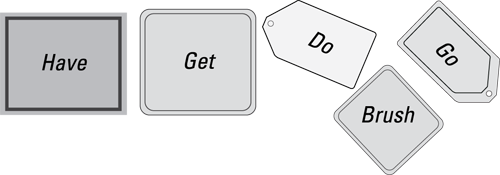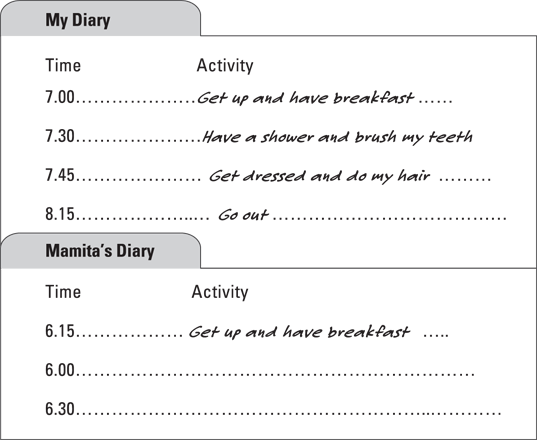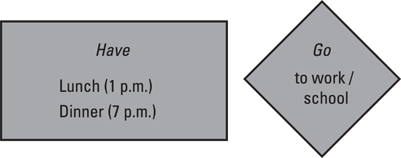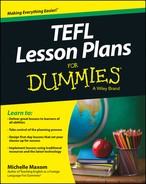Chapter 5
Back to Basics: Using Your Own Realia
In This Chapter
![]() Seeing how realia helps learning
Seeing how realia helps learning
![]() Bringing vocabulary learning to life using everyday objects
Bringing vocabulary learning to life using everyday objects
![]() Using realia in a lesson with students of different levels
Using realia in a lesson with students of different levels
One of the best things about TEFL is that it’s a job you can take anywhere in the world. This also means a class can take place in an endless variety of settings. So, although the internet offers a wealth of resources for teachers, and libraries crammed full of TEFL books are out there, you occasionally find yourself in a setting lacking the resources you would usually depend on and in which you have to rely on nothing but the contents of your own suitcase to engage your students.
Realia is basically ordinary stuff you use in the classroom. In this chapter, I show you how you can entertain and engage your learners with everyday objects such as food, timetables, clothes and general bric-a-brac.
Using Realia as Lesson Context
Before you balk at the idea of lugging loads of gear into the classroom, look at some of the benefits of using realia:
- Holding an object yourself is far more memorable than seeing a picture of one. So the realia-based lessons stay in students’ minds.
- You can appeal to the various intelligences and learning styles more easily (see Chapter 2 on NLP and Multiple Intelligences) when you have real props because some students learning better by moving an object around or by using visual input.
- Learners see language used in an authentic and contemporary way because realia tends to consist of things in current use.
- Realia teaches students about cultural differences because your realia may show something different from the typical objects in the students’ culture.
- Personal realia helps your class get to know you, and by sharing it you come across as being open and interesting.
- It’s quicker to hold up an object than to explain what its name means.
This lesson assumes students have basic knowledge of some language related to daily routine. It teaches learners how to describe some of the typical things people do on a daily basis.
Lesson overview
Vocabulary:
Get up
brush my teeth
have a shower
do my hair
get dressed
have breakfast
go out
Doing a warmer activity
![]() 5 minutes
5 minutes
Procedure: Put two anagrams on the board for students to decipher. Do the first one with them as an example. Then give them this one to lead into the topic:
dogo ringnom (good morning)
Alternatively, see how many smaller words students can make from this phrase.
Good morning (I, in, on, go, or, dog, door, god)
Presenting your morning routine
![]() 6 minutes
6 minutes
Procedure: Tell students the story of your morning routine twice, by describing what you do after using actions. Use the realia to add meaning. For example:
Every day, I get up at 7 o’clock. First I have breakfast . I have coffee and bread and butter. Next, I have a shower and brush my teeth. After that, I get dressed and domy hair. Then at 8 o’clock I go out.
![]() 3 minutes
3 minutes
Now mime the morning routine story. Let the students provide the commentary.
![]() 5 minutes
5 minutes
Pick up each item of realia in a random order, do the appropriate action connected with each item and elicit the vocabulary. Then step back and let a student do the actions and say the words for the class. The other students can help narrate the story.
Highlighting lexical chunks
![]() 6 minutes
6 minutes
Procedure: You need to help your students to recognise the lexical chunks (See the section on the Lexical Approach in Chapter 2) in the morning routine story. See Figure 5-1: Unlike the typical board work you do in class, I can’t use colour to group words here so I use shapes instead. The large shapes show the verbs used in more than one chunk. So where I put several words inside one shape, you may write those words together in the same colour to differentiate them from another group of words. In any case, set out these five verbs in separate parts of the board.

Figure 5-1: Example of board work for teaching lexical chunks according to their verbs.
Call out these words, or pairs of words, one by one:
Up / breakfast / a shower / my teeth / out / my hair / dressed
Elicit the right verb from the board which combines to make a lexical chunk in each case. So when you say up, the students should say get because get up is a chunk. Then write the words below the appropriate verb. So write up under the main heading get on the board. When the students have helped to place all the words in the correct place on the board, instruct them to record the information for future reference.
Creating routine diaries
![]() 5 minutes
5 minutes
Procedure: Ask students, one at a time, ‘What time do you get up?’ or ‘What time do you go out in the morning?’ Point to the clock as a clue.
What time /djə/ get up? What time do you get up?
Now create two diary pages on the board and demonstrate how to fill them by eliciting the morning routine you taught earlier from one of the students and writing in the activities. Then ask another student about his routine and write in one or two of his activities as examples.
![]() 5 minutes
5 minutes
Put the students in pairs. After making their own diary page (they can sketch it out in their notebooks) and writing in their own activities, they must interview a partner and note what he says on another diary page (see Figure 5-2). The students can use any vocabulary they know for this.

Figure 5-2: Example diary pages.
Transforming grammar
![]() /
/ ![]() 10 minutes
10 minutes
Procedure: Show students on the board that first and second person pronouns take the same verb structure in present simple sentences, as does the third person plural. Simply put it on the board like this (you don’t need to use strict grammaticaljargon):
I/you/we/they get up
Ask a student what time he gets up and elicit a response. Now see whether the class can complete the sentence correctly
Renny … up at 8 o’clock.
Ask another student of the opposite sex, if possible, and elicit a similar sentence.
Now it’s time to put the third person singular pronouns on the board. Start with ‘get up’ because it changes in the simplest and most typical way. Then elicit the third person forms of the other verbs on the board by holding up the items of realia you used earlier one by one and beginning a sentence with he/she; for example, hold the brush to elicit: She does her hair.
Figure 5-3 shows three things you can highlight on the board:
- The error students are likely to make unless you warn them
- The correct form of the verb
- How to pronounce the third person form of the verb

Figure 5-3: Example of board work showing verbs in the third person
Notice how the verbs change in different ways. Again, I use shapes here to group verbs which change in a similar way in the third person, whereas you could also use colour to highlight this on the board.
Practising using the third person for daily routines
![]() 5 minutes
5 minutes
Ask the students to find new partners. This time they need to use the third person in their discussion as they say what their previous partner’s routine is like and compare it to their own.
- St A: I get up at 7.00, but Renny gets up at 6.30. What time does Mamita get up?
- St B: Mamita gets up at 7.30 …
![]() 5 minutes
5 minutes
Have a feedback session to round off the activity. Pick one student to ask another what they know about a classmate. Toss a soft toy or ball around to indicate whose turn it is talk about a classmate.
- T: Mamita, tell me about Renny. What time does Renny go out?
- St C: Renny goes out at 8.30. Vanessa, what time does Andre eat breakfast?
- St D: He eats breakfast at 7.00 … .
If the students make any mistakes, get their peers to correct them.
And finally …
Have a rapid-fire round of holding up the realia and eliciting the corresponding phrase. Put one of the students in the driving seat if you prefer and finish off with a big round of applause.
Extension activities
Give the class some writing homework. Teach more lexical chunks that use the same five verbs from this lesson, like the ones in Figure 5-4, and get them to continue the diary entry for a whole day in time for the next session. This activity prompts students to search for new and relevant vocabulary to describe their activities.

Figure 5-4: Show students other expressions for daily routine using the same verbs.
In the next lesson the students can talk about their typical day and share new words with the class. After that, you can show them how to turn the diary into sentences and paragraphs by teaching connecting words (next, then and so on).

 Of course you don’t want your classroom to resemble a car boot sale and it doesn’t have to. Realia might involve the creative use of things you bring in anyway. For example, dress in the clothing that features in your vocabulary lesson, and use class mobile phones for role play dialogues and a real email for writing practice.
Of course you don’t want your classroom to resemble a car boot sale and it doesn’t have to. Realia might involve the creative use of things you bring in anyway. For example, dress in the clothing that features in your vocabulary lesson, and use class mobile phones for role play dialogues and a real email for writing practice. You need to have taught morning/afternoon/evening and telling the time before you try this lesson.
You need to have taught morning/afternoon/evening and telling the time before you try this lesson. Don’t feel under pressure to create worksheets every time. Save time and paper by explaining the idea and guiding the students to draft something themselves. You could turn it into a dictation exercise so that the students practise listening and writing.
Don’t feel under pressure to create worksheets every time. Save time and paper by explaining the idea and guiding the students to draft something themselves. You could turn it into a dictation exercise so that the students practise listening and writing.